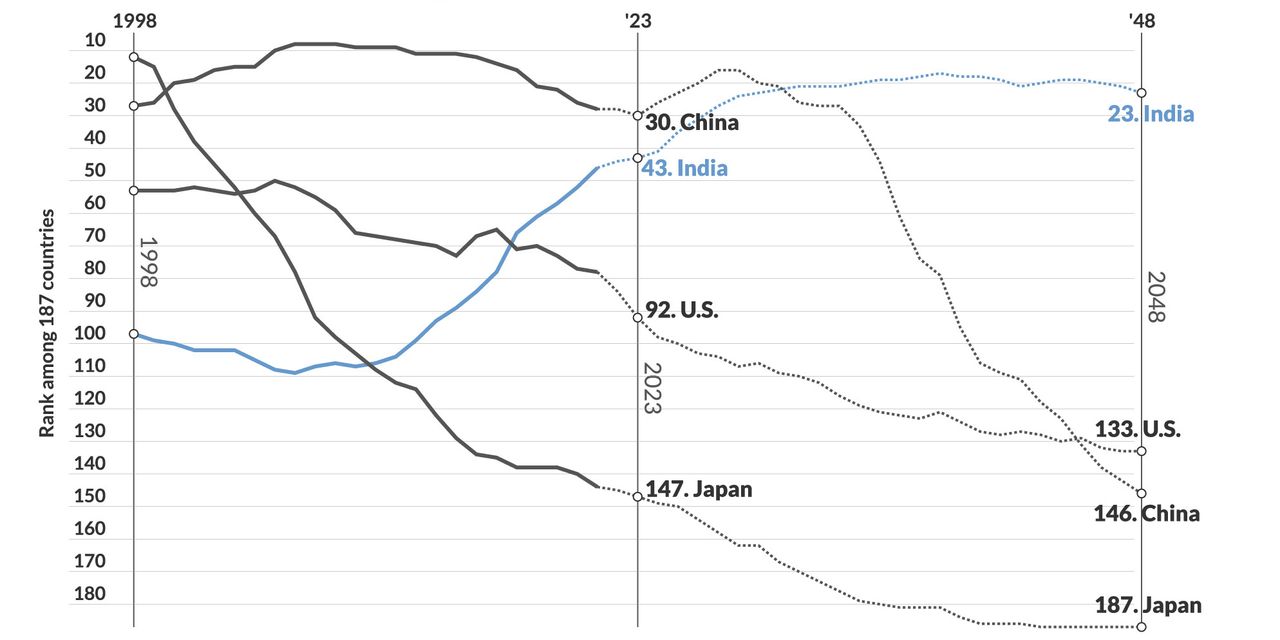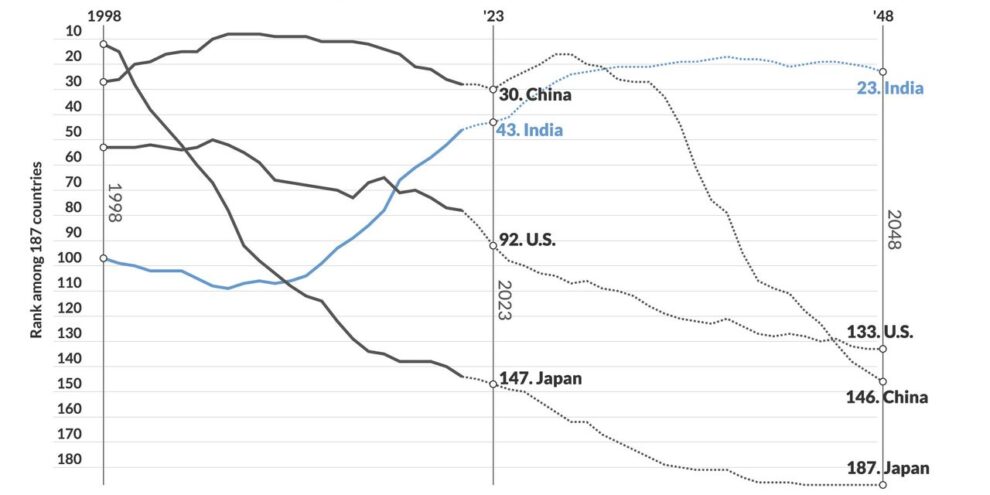
India became the world’s most populous country on Friday, ending China’s reign as No. 1, according to an analysis of United Nations population projections. The analysis shows that India’s population reached 1,425,782,975 on Friday.
India has overwhelming economic potential, not only due of its population size, but also because of its demographic makeup. This enormous competitive advantage can be seen in India’s dependency ratio.
The dependency ratio is a metric that compares a nation’s youth and elderly, who do not work, to its working population. The lower the ratio, the fewer non-workers a country needs to support. So for example, a nation with 50 dependents for every 100 workers will have a lower dependency ratio than a nation with 90 dependents for every 100 workers.
UN projections published in 2022 show that India’s dependency ratio is 47 dependents for every 100 workers in 2023, falling from where it sat 25 years ago at 68 dependents for every 100 workers. India’s dependency ratio is projected to fall to as low as 45-to-100 within the next 25 years before it starts rising in 2033. But even then, India’s dependency ratio is projected to be ranked No. 23 in the world in 2048, compared to its current rank of 43, based on a MarketWatch analysis of UN data. That’s a huge edge for the world’s most populous nation.
Today, China’s dependency ratio is slightly lower than India’s at 45 dependents for every 100 workers. But China’s dependency ratio is set to rocket higher in the years ahead, as an increasing portion of its population is made up of the young and elderly, supported by relatively fewer working-aged adults. This situation is largely the result of China’s one-child policy that ended in 2016. China’s dependency ratio will start rising in 2028 and reach 68-to-100 in 25 years, ranking it 146th among the world’s 193 countries.
India’s advantage
The country’s dependency ratio is projected to fall for the next 15 years
While demographic numbers indicate India has much to gain from its new status as the world’s most populous country, its full economic potential will not be reached if it continues to lag behind other emerging economies in terms of labor productivity and the female participation rate.
India is currently in its demographic dividend, a period of economic growth when the dependency ratio is low due to the age structure of its population. A country is considered to be in its demographic dividend when its fertility rate falls, and more women and caretakers enter the workforce as a result, which generally translates into a lower dependency ratio. But India might be leaving some of its economic dividend on the table.
A report from the United Nations Population Fund (UNPFA) outlines eight specific policies and initiatives the country should take to harness this pivotal period in India’s history, centering around two pillars. The first is individual health, which can be improved with more funding of healthcare, reproductive health and education. The second pillar is aimed at shifting the structure of the economy from agricultural to a manufacturing base.
However, the data points from the U.N. report that measure the support in India for the first pillar — the health of a new working population — indicate India is behind. Healthcare spending has not kept up with India’s rising gross domestic profit, and unmet needs for family planning are high compared to nearby countries, like China and South Korea. Women also have fewer opportunities to learn skills that would increase their participation in the labor force, the report said.
“Without proper policies, the increase in the working-age population may lead to rising unemployment, fueling economic and social risks,” according to the report.
India’s demographic numbers indicate the country has much to gain from its growing workforce and indeed the country has made some important strides to support its economic transition. But India trails behind other emerging and developed economies based on some metrics, a new book from the World Bank shows.
The World Bank’s measure of potential economic growth is divided into three categories— total factor productivity, capital accumulation and labor. While the South Asia Region, of which India is grouped, is the only emerging market and developing economy (EMDE) to not have suffered a decline in overall potential growth in the past decade compared to the 10 years before it, that is mainly because of improvements in total factor productivity and capital accumulation. Growth from capital accumulation and labor is where India trails behind.
Total factor productivity, which occurs via a more efficient use of inputs through technological changes, has been the largest contributor to potential economic growth in South Asia in the past two decades, according to the World Bank report. In India, total factor productivity far exceeds that of the three largest economies, the U.S., China and Japan. This can be attributed to India’s transition from an agricultural economy to manufacturing.
Capital accumulation growth potential in India is below China but above the U.S. and Japan, even though other countries in the South Asia region — Bangladesh, Bhutan and Nepal — have strong investment. India\’s weak capital accumulation potential is due to policy uncertainties and structural bottlenecks from unreliable power and transportation networks, according to the World Bank report.
Labor is the area with the smallest amount of economic growth potential in India, compared to the two other categories. This is largely because of educational challenges that limit the potential of labor to contribute more to economic growth in India, where only 40% of the population completed secondary school in the 2010s. This is only a five percentage point increase from the decade prior, the second smallest of the six EMDE regions. And the pandemic\’s impact on school completion rates will be a new wrench in this area of growth potential, according to the World Bank report.
“Human capital will have been eroded by lower participation rates, disruptions to education, and a deterioration in health outcomes.” according to the World Bank’s report.
While India has ambitious reforms planned, the World Bank sees opportunities to accelerate their implementation. The actions that will make the biggest impact are those that formalize the workforce and encourage a higher female labor participation rate to match that of other EMDEs.











Add Comment